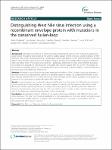Distinguishing West Nile virus infection using a recombinant envelope protein with mutations in the conserved fusion-loop
Chabierski, Stefan
Barzon, Luisa
Papa, Anna
Niedrig, Matthias
Bramson, Jonathan L.
Richner, Justin M.
Palù, Giorgio
Diamond, Michael S.
Ulbert, Sebastian
Background: West Nile Virus (WNV) is an emerging mosquito-transmitted flavivirus that continues to spread and cause disease throughout several parts of the world, including Europe and the Americas. Specific diagnosis of WNV infections using current serological testing is complicated by the high degree of cross-reactivity between antibodies against other clinically relevant flaviviruses, including dengue, tick-borne encephalitis (TBEV), Japanese encephalitis (JEV), and yellow fever (YFV) viruses. Cross-reactivity is particularly problematic in areas where different flaviviruses co-circulate or in populations that have been immunized with vaccines against TBEV, JEV, or YFV. The majority of cross-reactive antibodies against the immunodominant flavivirus envelope (E) protein target a conserved epitope in the fusion loop at the distal end of domain II. Methods: We tested a loss-of-function bacterially expressed recombinant WNV E protein containing mutations in the fusion loop and an adjacent loop domain as a possible diagnostic reagent. By comparing the binding of sera from humans infected with WNV or other flaviviruses to the wild type and the mutant E proteins, we analyzed the potential of this technology to specifically detect WNV antibodies. Results: Using this system, we could reliably determine WNV infections. Antibodies from WNV-infected individuals bound equally well to the wild type and the mutant protein. In contrast, sera from persons infected with other flaviviruses showed significantly decreased binding to the mutant protein. By calculating the mean differences between antibody signals detected using the wild type and the mutant proteins, a value could be assigned for each of the flaviviruses, which distinguished their pattern of reactivity. Conclusions: Recombinant mutant E proteins can be used to discriminate infections with WNV from those with other flaviviruses. The data have important implications for the development of improved, specific serological assays for the detection of WNV antibodies in regions where other flaviviruses co-circulate or in populations that are immunized with other flavivirus vaccines.
No license information

